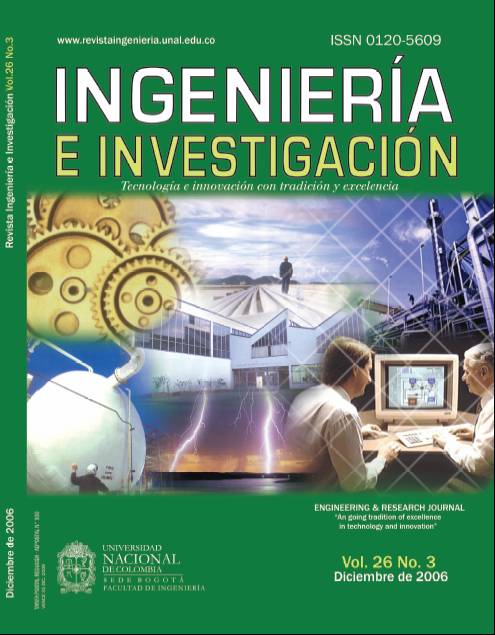Behavior of cold-formed thin steel sections (MM) under concentrated loads
Determinación del comportamiento bajo cargas concentradas de perfiles de lámina delgada (MM)
DOI:
https://doi.org/10.15446/ing.investig.v26n3.14744Keywords:
cold-formed steel, web crippling, stiffeners, hysteresis, finite elements, MM section, concentrated loads. (en)acero laminado en frío, arrugamiento del alma, rigidizadores, histéresis, elementos finitos, perfil MM (es)
Downloads
New sections are continually being developed in the cold-formed steel world to improve the performance of existing sections. M-section development provides an example of improving C-sections’ shear resistance and web crippling resistance against C-sections’ concentrated loads. C-sections’ shear nominal strength can be achieved through locating tow web intermediate stiffeners (M-sections) even though web crippling resistance cannot be increased in the same way. Such intermediate stiffeners mean that M-section stresses and deflections cannot be analysed with traditional material mechanics. Concentrated loads cause this behavior to become increased; 4 different models and 3 tests for each of them were thus developed, as well as determining M-sections’ theoretical resistance (based on 1996 AISI). The values obtained corresponded to maximum resistance load, visual identification of any possible type of failure, deflections (at middle span) and deformations (εx, εy, εxy). Mathematical models were also used for comparing the finite element method and simplified mathematical models’ test results for a detailed review of MM-section stress and deformation. These models were calibrated on the test results. After the failure mode was identified for each model, MM-section maximum resistance load was compared to nominal load (according to AISI formulation, also aiding formulating nominal strength calculation). The information obtained from tests and mathematical models was analysed to observe parameter (∆, σ y T) tendencies respecting applied load (P). Cyclic tests under pseudo-static loads were performed to study MM-sections’ hysteretic behavior.
En el campo de la lámina delgada continuamente aparecen nuevos tipos de perfiles que son desarrollados con el objeto de mejorar los ya existentes. Un ejemplo de esto es la aparición del perfil M, elaborado para mejorar la eficiencia a corte del perfil C y su resistencia al arrugamiento del alma por efecto de cargas concentradas.
Teóricamente, se logra el objetivo de mejorar la resistencia a corte del perfil C y de algún modo su resistencia al arrugamiento del alma, pero debido a los dobleces generados en el alma (rigidizadores intermedios) para acortar la longitud de pandeo, se producen comportamientos que desde el punto de vista de esfuerzos por flexión y deflexiones no pueden ser analizados con los fundamentos teóricos de la mecánica tradicional. Este comportamiento se ve acentuado con la presencia de cargas concentradas. Por la razón expuesta anteriormente, a parte de la determinación de la resistencia teórica del perfil M (basada en el AISI 1996), se desarrollan pruebas sobre cuatro modelos de los que se obtienen tópicos como: carga máxima resistida, identificación visual del posible tipo de falla, deflexiones (centro de la luz) y deformaciones unitarias (εx, εy, εxy), y adicionalmente se elaboran modelos matemáticos simplificados y por elementos finitos (en el programa COSMOS/M), con el fin de hacer una revisión detallada del comportamiento de los esfuerzos y deformaciones en el perfil. La calibración de estos modelos se lleva a cabo con base en los resultados obtenidos de los ensayos. De otra parte, se hacen pruebas cíclicas bajo cargas pseudoestáticas, con el objeto de estudiar el comportamiento histerético del perfil MM, con y sin rigidizadores.
References
American Iron and Steel Instituye (AISI)., Cold Formed Steel Design Manual, 1996.
Andrade Ordoñez, V. M., Diseño de Placas en Sección Compuesta Empleando Perfiles C en Lámina Delgada, Formados en Frio como Viguetas de Soporte Lamina Colaborante - Steel Deck como Tablero de Refuerzo de la Torta Superior. Universidad Nacional de Colombia. Colombia, 1998.
Caro, G. J. y Muñoz, G. D., Comportamiento a flexión del sistema conformado por un perfil MM y una losa aligerada compuesta por concreto, perfil omega y bloque de arcilla., Universidad Nacional de Colombia, Colombia, 2003.
Gaylord Jr, E. H., Steel Structures., Third Edition, Mc Graw Hill, 1992.
Hetrakul, N. and Yu, W. W., Structural Behavior of Beam Webs Subjected to Web Crippling and a Combination of Web Crippling and Bending., Final Report, Civil Engineering Study 78-4, University of Missouri - Rolla, Rolla, MO, June, 1978.
Hotmeyer, H., Combined web crippling and bending moment failure of first-generation trapezoidal steel sheeting., Universidad de Eindhoven, 2000.
LaBoube, R. A. and Yu, W. W., Structural Behaviour of Beam Webs Subjected Primarily to Shear Stress., Final Report, Civil Engineering Study 78-2, University of Missouri-Rolla, Rolla, MO, June, 1978.
Ortiz Porras, J. A., Determinación del comportamiento bajo cargas concentradas de perfiles de lámina delgada (MM)., Tesis de Maestría, para optar al título de Msc en Estructuras, Universidad Nacional de Colombia, Facultad de Ingeniería Civil y Agrícola, 2006.
Timoshenko, G., Mecánica de Materiales., Segunda Edición, Grupo Editorial Ibero América, California, 1986.
Valencia Clement, G., Estructuras de Acero. Diseño con factores de carga y de resistencia., Editorial Escuela Colombiana de Ingeniería, Bogotá, 1997.
Winter, G., Discusión of “Strength of Beams as Determined by Lateral Buckling”, by Karl de Vries., Transactions, ASCE, Vol. 112, 1947. DOI: https://doi.org/10.1061/TACEAT.0006000
Yu, W. W., Cold Formed Steel Design., Segunda Edición, John Wiley and Sons, INC. 1991.
How to Cite
APA
ACM
ACS
ABNT
Chicago
Harvard
IEEE
MLA
Turabian
Vancouver
Download Citation
CrossRef Cited-by
1. Anying Chen, Shilong Yan, Qing Jiang, Hanqin Wang, Yuetong Wang, Haiying Wan. (2025). Seismic performance of M‐section lightweight steel‐reinforced concrete shear walls. Structural Concrete, https://doi.org/10.1002/suco.70122.
2. Guowei Zhang, Qiaoqiao Fan, Zheng Lu, Dongxu Qiao. (2022). Seismic Performance of M-Section Cold-Formed Thin-Walled Steel-Reinforced Concrete Wall. Journal of Structural Engineering, 148(9) https://doi.org/10.1061/(ASCE)ST.1943-541X.0003453.
Dimensions
PlumX
Article abstract page views
Downloads
License
Copyright (c) 2006 Maritzabel Molina Herrera, Javier Alberto Ortíz Porras

This work is licensed under a Creative Commons Attribution 4.0 International License.
The authors or holders of the copyright for each article hereby confer exclusive, limited and free authorization on the Universidad Nacional de Colombia's journal Ingeniería e Investigación concerning the aforementioned article which, once it has been evaluated and approved, will be submitted for publication, in line with the following items:
1. The version which has been corrected according to the evaluators' suggestions will be remitted and it will be made clear whether the aforementioned article is an unedited document regarding which the rights to be authorized are held and total responsibility will be assumed by the authors for the content of the work being submitted to Ingeniería e Investigación, the Universidad Nacional de Colombia and third-parties;
2. The authorization conferred on the journal will come into force from the date on which it is included in the respective volume and issue of Ingeniería e Investigación in the Open Journal Systems and on the journal's main page (https://revistas.unal.edu.co/index.php/ingeinv), as well as in different databases and indices in which the publication is indexed;
3. The authors authorize the Universidad Nacional de Colombia's journal Ingeniería e Investigación to publish the document in whatever required format (printed, digital, electronic or whatsoever known or yet to be discovered form) and authorize Ingeniería e Investigación to include the work in any indices and/or search engines deemed necessary for promoting its diffusion;
4. The authors accept that such authorization is given free of charge and they, therefore, waive any right to receive remuneration from the publication, distribution, public communication and any use whatsoever referred to in the terms of this authorization.




























